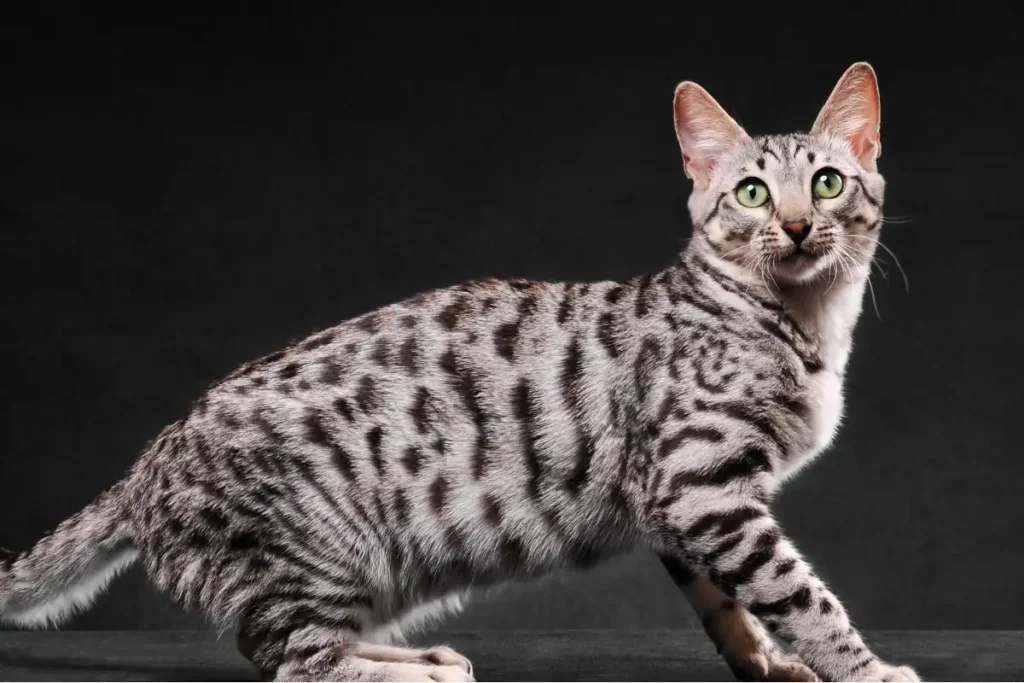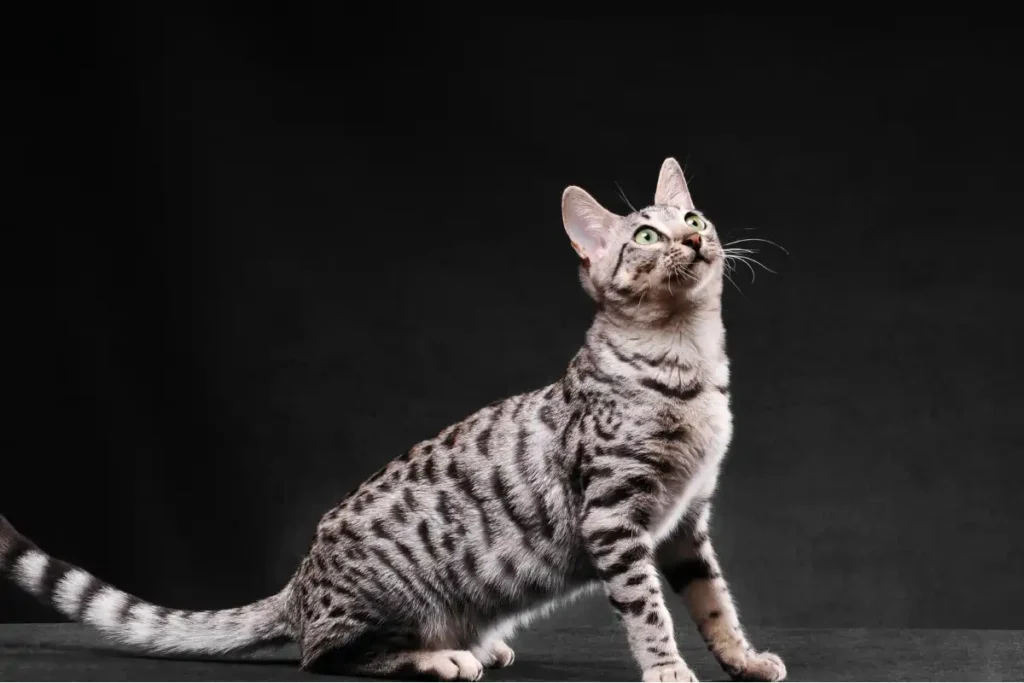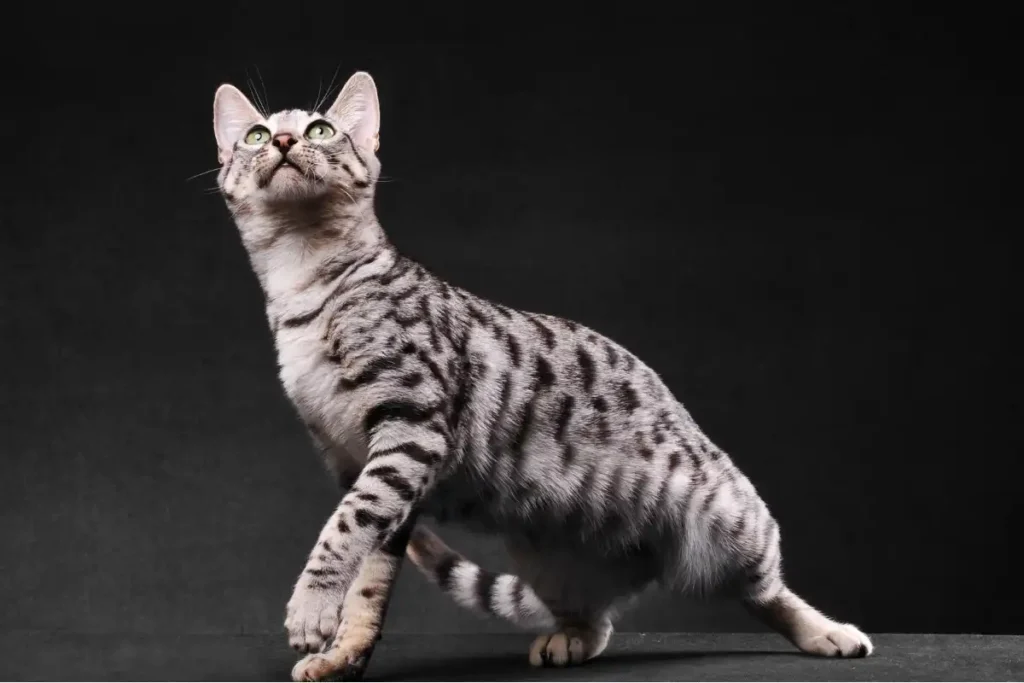If you’re looking for a cat with elegance, wild beauty, and playful energy, the Bengal cat white might be perfect. This stunning feline often looks like a tiny snow leopard. It belongs to a breed known for bold markings and exotic charm. Add a snowy coat, and the Bengal becomes even more unforgettable. Cat lovers everywhere have taken notice of this rare beauty—and for good reason.
The Bengal cat breed started in the 1960s. People mixed domestic cats with a wild cat called the Asian leopard cat. Their goal was simple: create a pet with a wild look and a gentle nature. Today, Bengals have become a favorite among pet owners and cat fanciers alike. They’re admired for their flashy coats, sharp minds, and affectionate behavior.
Bengals come in many coat patterns and colors. Some wear golden or silver coats; others show off rich marbling or leopard-like spots. But one variety stands out—the Bengal cat white, also called the snow Bengal. This version mixes soft, pale fur with the breed’s signature markings. The result is a breathtaking look that draws attention and sparks curiosity.
Whether you’ve had cats for years or are looking for your first, the white Bengal cat offers something truly special. In the sections ahead, you’ll learn more about their genetics, coat types, and unique personality. By the end, you’ll understand why so many people are falling in love with this rare feline treasure.
Introduction to the Bengal Cat Breed
The Origin and Popularity of Bengal Cats
The Bengal cat’s journey began when breeders combined domestic cats with the Asian leopard cat, a small, wild feline native to Asia. Jean Mill, an American breeder, played a pivotal role in this development during the 1960s and 1970s. She envisioned a cat that looked wild but behaved like a loving house pet. Through careful breeding and dedication, the Bengal cat emerged—a feline that captured the mystique of the jungle in a playful, social package.
Since then, Bengal cats have soared in popularity around the globe. Their exotic appearance, muscular build, and high-energy personalities make them stand out in any home. From show rings to family living rooms, Bengal cats captivate everyone they meet. As more people discover rare variations like the Bengal cat white, interest in this breed continues to grow among cat lovers and breeders alike.
What Sets Bengal Cats Apart from Other Exotic Cat Breeds
Many exotic cat breeds have stunning looks, but Bengal cats bring a perfect blend of wild beauty and domestic charm. Unlike other exotic breeds that may appear aloof or reserved, Bengals stay active, affectionate, and deeply interactive with their families. They thrive on mental stimulation and love to climb, fetch, and explore every inch of their surroundings.
Their leopard-like spots and marbled coats give them an unmistakable wild look, yet their personalities are surprisingly people-friendly. Bengal cats build strong bonds with their owners, often following them around the house or learning tricks. What truly sets them apart, especially the Bengal cat white, is their ability to look like a rare snow cat while acting like a loyal, playful companion.
Overview of Bengal Cat Coat Patterns and Unique Characteristics
Bengal cats display one of the most diverse and visually striking coats in the feline world. Their coats come in a range of patterns, including spotted, marbled, and even rosetted—the kind you’d find on a leopard or jaguar. These markings sit on top of background colors like brown, silver, and snow, with the latter giving rise to the stunning Bengal cat white variety.
But Bengal cats aren’t just beautiful—they’re also known for their silky, glittery fur that shimmers in the light. This glitter effect gives their coats a sparkling finish that’s especially eye-catching on lighter-colored Bengals. Combined with their athletic build, vivid eye colors, and expressive faces, Bengal cats leave a lasting impression. Every pattern, every trait tells a story of wild ancestry fused with modern elegance.
The Allure of the White Bengal Cat
What Is a White Bengal Cat? (Including Snow Bengal Variations)
A white Bengal cat isn’t truly pure white like an albino cat. Instead, the term often refers to a snow Bengal, a beautiful variant of the Bengal breed with a light, icy coat that ranges from creamy ivory to pale beige or silver. These cats carry specific genetic traits that dilute the typical brown or gold Bengal coloring, resulting in a snowy appearance paired with soft spots or marbling.
Snow Bengals come in three primary types based on their genetic makeup: Seal Lynx Point, Seal Mink, and Seal Sepia. Each variation offers a slightly different shade and eye color combination, from bright blue to aqua or even green. Although some people refer to them as “white Bengals,” these cats still retain the wild, leopard-like patterns that make Bengals so distinctive. The Bengal cat white variation draws admiration for its elegance and soft contrast, offering a cooler, more ethereal version of the classic Bengal.
Pure White Bengal Cat vs. Snow Bengal: Differences and Misconceptions
Many cat lovers assume that snow Bengals and pure white Bengals are the same, but there’s a subtle difference worth noting. A pure white Bengal cat, in the strictest sense, does not exist as a naturally occurring standard. What people often refer to as “pure white” Bengals are actually snow Bengals with very light patterns or faded markings, giving the illusion of a completely white coat.
Snow Bengals still carry the breed’s signature patterns, even if they’re faint. On the other hand, a cat that is genetically solid white with no markings does not fit within the recognized Bengal breed standards. It’s a common misconception that these two are interchangeable, but the snow Bengal’s beauty lies in its soft contrast and the presence of subtle spots or marbles. Enthusiasts looking for a Bengal cat white are typically referring to the snow Bengal, not a completely white, patternless version.
Why White Bengal Cats Are Considered Rare Bengal Cat Colors
White Bengal cats—or more accurately, snow Bengals—are rare due to the specific genetics required to produce their unique coloring. Breeding a snow Bengal involves careful pairing of cats with recessive genes for lighter coats. This process takes time and precision, making these cats less common than the traditional brown or golden Bengals found more frequently.
In addition to their rarity, the visual appeal of their light coats with pale rosettes or marbled markings contributes to their high demand. Cat lovers often seek out these rare Bengal cat colors because they look exotic yet elegant, like miniature snow leopards lounging in your living room. A Bengal cat white combines the thrill of wild feline beauty with the warmth of a domestic companion, making it a prized find among breeders and pet owners alike.

Genetics Behind the White Bengal Coat
Coat Color Genetics: How White and Snow Variations Occur
The mesmerizing look of a Bengal cat white starts at the genetic level. Snow Bengals, which are often referred to as white Bengals, inherit their pale coloring from specific recessive genes passed down from their parents. Three main gene types contribute to snow coloration: the Seal Lynx Point gene (inherited from Siamese ancestry), the Seal Mink gene, and the Seal Sepia gene (from Burmese ancestry). Each of these influences how light or creamy the coat appears.
To produce a Bengal with a snow or white appearance, both parent cats must carry at least one copy of the recessive gene. When two carriers are bred, their kittens have a chance of expressing the snow coloration. This complex inheritance pattern makes the snow Bengal relatively rare, and the stunning Bengal cat white coloring even more so when paired with crisp patterns and clear blue or aqua eyes.
Role of Selective Breeding and Cat Breed Standards
Selective breeding plays a crucial role in developing and maintaining the Bengal cat’s exotic beauty. Breeders who specialize in snow Bengals must understand feline genetics thoroughly to produce healthy kittens with the desired coat colors and patterns. Achieving a light, snow-colored coat while preserving vivid markings and strong structure takes generations of careful breeding.
Breed standards established by organizations like TICA (The International Cat Association) guide breeders in refining these traits. Standards define acceptable colors, patterns, body types, and even eye color ranges for show-quality Bengals. The Bengal cat white must still meet these strict guidelines, including maintaining visible contrast in its markings. Breeders who meet these standards help preserve the Bengal’s wild look while ensuring the cat remains healthy and true to the breed.
Spotted vs. Marbled Patterns in White Bengals
When it comes to coat patterns, Bengal cats typically display two stunning variations: spotted and marbled. These patterns appear in all Bengal colors, including snow Bengals. A spotted Bengal features rosettes or single spots that mimic the look of wild leopards or ocelots. Marbled Bengals, on the other hand, have swirling patterns that create a more fluid, dramatic effect across their coat.
In the case of a Bengal cat white, the contrast between the pale background and the pattern is what sets the cat apart. Spotted white Bengals often have a cleaner, more defined look, especially when the markings are dark against the light base. Marbled white Bengals offer a more artistic, abstract appearance that stands out beautifully on their pale fur. Both patterns are breathtaking and reflect the breed’s deep connection to its wild ancestors.

Personality and Traits of White Bengal Cats
Typical Bengal Cat Personality: Energetic, Curious, and Intelligent
Bengal cats bring a level of energy and intelligence that keeps their owners constantly engaged. These cats don’t just lounge around all day—they climb, leap, chase toys, and even learn tricks. Many Bengals enjoy games like fetch, solve puzzle toys, and some even figure out how to open doors or turn on faucets. Their curious minds and strong instincts make them natural explorers who want to be involved in everything.
When you welcome a Bengal cat white into your home, you’re not just adding a stunning pet—you’re bringing in a companion with a bold personality. These cats thrive in environments that challenge them, both physically and mentally. They form strong bonds with their humans and often follow them from room to room, eager to participate in daily routines. Their personality matches their appearance: striking, dynamic, and impossible to ignore.
Bengal Cat Eye Color: What to Expect in White Bengals
One of the most captivating features of any Bengal is its eye color, and this becomes even more striking in snow or white Bengals. Depending on the specific snow gene a Bengal carries, eye colors can range from icy blue to rich aqua or even green. Seal Lynx Point Bengals, the lightest snow variety, almost always have vivid blue eyes. Seal Mink Bengals often have aqua eyes, while Seal Sepias may show shades of green or gold.
In a Bengal cat white, the eye color adds to the overall impression of elegance and wild beauty. The contrast between the pale coat and piercing eyes gives them an almost mystical appearance. Breeders and cat enthusiasts alike admire this trait, as the eyes offer a window into the cat’s alert, intelligent nature. It’s one of the many features that makes a Bengal cat white unforgettable.
Are White Bengal Cats Hypoallergenic? (Exploring Allergy-Friendly Qualities)
While no cat is truly 100% hypoallergenic, Bengal cats often cause fewer allergic reactions than other breeds. This is because Bengals produce lower levels of the Fel d 1 protein in their saliva and skin—the protein most responsible for triggering cat allergies. In addition, their short, fine coats shed less than many other breeds, which helps minimize dander around the home.
Many allergy sufferers report fewer symptoms when living with a Bengal, including the snow or white variety. If you’re considering a Bengal cat white and have mild allergies, it might be worth spending some time with one before making a decision. While individual reactions vary, Bengal cats have earned a reputation as one of the more allergy-friendly options among exotic breeds.
Is a White Bengal Cat Right for You?
Feline Behavior and Care Requirements for Bengal Cats
Bengal cats need more than just food and a cozy bed—they crave stimulation, interaction, and plenty of room to explore. These cats behave more like active companions than laid-back lap pets. They love to climb, chase, and interact with their surroundings. Providing cat trees, climbing shelves, and puzzle feeders keeps them mentally and physically satisfied.
You should expect a Bengal to demand your attention and involvement. They often “talk” with a range of chirps and meows, and they aren’t shy about expressing their opinions. When you adopt a Bengal cat white, you’re signing up for a pet that thrives on adventure and affection. They do best in homes that match their energy and give them space to move freely and play often.
Pet Ownership Tips: What to Know Before Bringing One Home
Before you bring a Bengal into your life, prepare for a cat that behaves more like a playful toddler than a typical feline. Bengals do best with owners who can match their energy levels and provide enriching environments. If you’re away from home for long hours, consider adopting a second pet for companionship—or risk coming home to a mischievous masterpiece of shredded toilet paper and overturned plants.
It’s also important to note that Bengals are highly intelligent and get bored quickly. Rotating toys, creating obstacle courses, and even training them with clickers can help keep them happy. Owning a Bengal cat white means you’re taking in a cat with both beauty and brains—so be ready to invest time in both bonding and play.
Why Cat Fanciers and Cat Lovers Are Drawn to This Exotic Feline
Few cat breeds spark as much admiration as the Bengal. With their wild looks and domestic temperament, they’re the perfect blend of exotic and affectionate. Cat fanciers love the Bengal’s sleek, muscular body, shimmering coat, and bold markings. Casual pet lovers fall for their playful nature, engaging personality, and the deep connection they form with their humans.
The Bengal cat white holds even more appeal due to its rarity and stunning appearance. It’s a cat that stops people in their tracks, whether at home, in photos, or on social media. For anyone who loves animals with a little extra flair—and a lot of personality—a white Bengal offers the total package: intelligence, beauty, and a hint of the wild.

Conclusion
The Bengal cat white isn’t just another pretty face in the feline world—it’s a rare and breathtaking blend of wild beauty, intelligence, and charm. From its snow-kissed coat to its piercing blue or aqua eyes, this cat captures attention and hearts wherever it goes. But its appeal goes beyond appearance. With a personality that’s playful, affectionate, and endlessly curious, the Bengal makes every day more exciting for its owner.
Whether you’re drawn to the snow Bengal’s elegant patterns or the mythic allure of a nearly white Bengal, this variation represents one of the most striking and desirable in the breed. The Bengal cat white stands out not only for its rarity but for how it embodies everything people love about Bengals—energy, elegance, and an unmistakable presence.
Owning a Bengal takes commitment, but the rewards are unmatched. If you’re ready for a feline companion that offers adventure, companionship, and eye-catching beauty all in one sleek package, the Bengal cat white might just be your perfect match.
As more cat lovers discover the magic of this rare variation, its popularity will only continue to grow. If you get the chance to meet or adopt one, don’t hesitate—you’ll be welcoming a living work of art into your life, one that purrs, plays, and fills your home with joy.
Read More About this Unique Cat Breed in this Article!
Discover the Silver Bengal Cat Breed In this Article!
Not All Bengal Cats are Legal ! Learn more About The Bengal Cats Legality in this Article!
Discover more About the Latest Tips For All Different Cats From HERE.
Looking For Good stuff for your Cat? Look no Further and Visit Pet MD Official.
